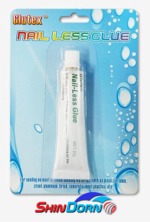Factory OEM services for silicone gel. Excellent waterproofing and mold resistant properties!
Back To Product Information List
Details:
Packaging Details144 cards-master carton-42.5×50.5×43.5 cm |
|
|
Main Features: High quality silicone gel for bonding plastic, glass, metal and ceramics. Water resistant and mould resistant properties. Branded packaging for your market. Complies with: US and EU standards: ASTM F963-11, RoHS and REACH SVHC. Our Products have been sold to: United Kingdom and United States! Shin Dorn Manufacturing: Silicone gel is adhesive ideal for bonding, sealing and waterproofing a variety of materials and surfaces, such as glass, mirror, metal, aluminum, ceramics and many hard plastics. Shin Dorn adopts silicone gel supplied by Dow Corning, with excellent waterproof and mould resistant properties. Shin Dorn specializes in repackaging services. To ensure shelf life of adhesive, Shin Dorn has delicate lacquer coating and latex lining procedures to effectively prevent leakage. Both acetic silicone sealant and neutral silicone sealant are available. Factory wholesale offers you the most competitive pricing. |
|
| Quick Details | |
| Product Type: | Silicone gel, liquid nails adhesive |
| Raw Material: | Dow Corning silicone sealant – Acetic silicone sealant |
| Glue Color: | Colorless |
| Specification: | 20 gram |
| Model Number: | GS019 |
| Usage: | Liquid nails: for bonding metal or plastic wall hooks, hangers, racks, etc. For bonding, sealing and waterproofing glass, mirror, metal, aluminum, ceramics and hard plastics. Most commonly used in bathroom and kitchen. |
| Target Markets: | Adhesive glue for bonding glass, mirror, metal, aluminum, ceramics and hard plastics.Waterproof sealant for glass, mirror, metal, aluminum, ceramics and hard plastics. |
| Product Categories: | Adhesives and sealants. Accessory item for bath set and kitchen set. Bathroom accessory |
| Shelf Life: | 12 Months |
| Regulations: | Silicone gel complies with the following regulations: ASTM F963-11 for Total lead in paint and similar surface-coating materials.ASTM F963-11 for soluble heavy metal in Substrate Materials/paint and similar surface-coating materials. RoHS for 6 restricted materials. Substances in the Candidate List of Substances of Very High Concern (SVHC). |
| Company Certificates: | ISO9001:2015 Quality Management System |
| Customizations: | Custom repackaging services of silicone gel, with raw material from Dow Corning or provided by client. Custom sizes of silicone gel filled in aluminum collapsible tube. Flexible packaging options: blister pack, double blister pack, paper box, plastic container or bulk pack. Production date marked on tube. |
| Physical Properties | |
| Appearance: | Colorless paste |
| Main Ingredients: | Hydrotreated middle petroleum distillates. Methyltriacetoxysilan Ethyltriacetoxysilane |
| Odor: | Acetic acid odor |
| Properties: | Fast curing, excellent waterproof and adhesive performance. Remains flexible after curing and resists cracking and vibration. Durable, withstanding high temperatures. Used for building joints, sealing seams and waterproofing. Colorless and can thus blend into its surrounding surfaces. Releases acetic acid as it cures and smells a bit like vinegar. |
| Corrosivity: | Reactive with water or moisture. Might cause burns if swallowed |
| Curing Time: | Dry to touch in 60 minutes; Fully dry out and cure in 24 hours. |
| Flash Point: | 212°F (100ºC) (Closed Cup) |
| Stability: | Stable |
| Specific Gravity: | 1.03 |
| Storage: | Keep containers tightly closed to avoid contamination or in contact with oxidizers, water or moisture. Keep away from food and drinks. Keep out of the reach of children |
| Flammability: | Non |
| Application Guidelines | |
| Service Temperature: | -58°F to 482°F (-50ºC to 250ºC) |
| Method of Application: | Scraper |
| Instructions: | How to apply silicone adhesive? 1. Be sure to use silicone adhesive with adequate ventilation. 2. Before applying silicone adhesive, make sure the surface is clean and dry, free of dust, dirt and oil. It is recommended to wipe off the work area with alcohol patch. 3. Apply proper amount of adhesive to the surface. Squeeze the tube steadily and evenly. 4. Use a scraper to spread the adhesive evenly and wipe off adhesive residue if necessary. 5. Allow adhesive to dry. It might take up to 48 hours to cure if the work area is large. |
| Cleanup: | Wipe up or scrape up material or its residue completely since some silicone material, even in small quantity, may present a slip hazard. Final cleanup may require use of steam, solvents or detergents. Dispose of saturated absorbant or cleaning materials appropriately, since spontaneous heating may occur. Avoid soil, water and drains contamination. Dispose of this material as well as those materials and items employed in the cleanup in accordance with current government regulations. |
| Precautions: | Not classified as hazardous. Acetic acid (HOAc) is formed upon contact with water or humid air. Adopt proper ventilation during use to control HOAc exposures. Do not swallow. Avoid contact with skin and eyes. Skin contact or direct eye contact may cause moderate irritation. Material can react with strong oxidizing agents. Water, moisture or humid air can cause hazardous vapors to form. Combustion may produce carbon oxides and traces of incompletely burned carbon compounds, as well as silicon dioxide and formaldehyde |
| First-Aid: | In case of eye contact, flush eye(s) cautiously with plenty of water for at least 15 minutes and consult physician. In case of skin contact, rinse skin with soap and plenty of water for at least 15 minutes. Consult physician if irritation or other symptoms persist. If swallowed, consult physician immediately. In case of fire, use carbon dioxide (CO2), dry chemical powder or water spray for extinguishing. Water can be used to cool fire exposed containers |
This Post Has One Comment
Comments are closed.


Pingback: Advantages of Small Pack Silicone Glue